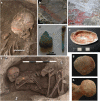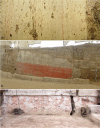New insights on commemoration of the dead through mortuary and architectural use of pigments at Neolithic Çatalhöyük, Turkey
- PMID: 35260577
- PMCID: PMC8904496
- DOI: 10.1038/s41598-022-07284-3
New insights on commemoration of the dead through mortuary and architectural use of pigments at Neolithic Çatalhöyük, Turkey
Abstract
The cultural use of pigments in human societies is associated with ritual activities and the creation of social memory. Neolithic Çatalhöyük (Turkey, 7100-5950 cal BC) provides a unique case study for the exploration of links between pigments in burials, demographic data and colourants in contemporary architectural contexts. This study presents the first combined analysis of funerary and architectural evidence of pigment use in Neolithic Anatolia and discusses the possible social processes underlying the observed statistical patterns. Results reveal that pigments were either applied directly to the deceased or included in the grave as a burial association. The most commonly used pigment was red ochre. Cinnabar was mainly applied to males and blue/green pigment was associated with females. A correlation was found between the number of buried individuals and the number of painted layers in the buildings. Mortuary practices seem to have followed specific selection processes independent of sex and age-at-death of the deceased. This study offers new insights about the social factors involved in pigment use in this community, and contributes to the interpretation of funerary practices in Neolithic Anatolia. Specifically, it suggests that visual expression, ritual performance and symbolic associations were elements of shared long-term socio-cultural practices.
© 2022. The Author(s).
Conflict of interest statement
The authors declare no competing interests.
Figures







Similar articles
-
Red pigments and Boraginaceae leaves in mortuary ritual of late Neolithic China: A case study of Shengedaliang site.Microsc Res Tech. 2017 Feb;80(2):231-238. doi: 10.1002/jemt.22791. Epub 2016 Oct 11. Microsc Res Tech. 2017. PMID: 27726230
-
Variable kinship patterns in Neolithic Anatolia revealed by ancient genomes.Curr Biol. 2021 Jun 7;31(11):2455-2468.e18. doi: 10.1016/j.cub.2021.03.050. Epub 2021 Apr 14. Curr Biol. 2021. PMID: 33857427 Free PMC article.
-
Analysis of Red Pigments from the Neolithic sites of Çatalhöyük in Turkey and Sheikh-e Abad in Iran.Spectrochim Acta A Mol Biomol Spectrosc. 2014 Oct 15;131:373-83. doi: 10.1016/j.saa.2014.03.126. Epub 2014 Apr 16. Spectrochim Acta A Mol Biomol Spectrosc. 2014. PMID: 24835941
-
Bioarchaeological contributions to the study of violence.Am J Phys Anthropol. 2015 Feb;156 Suppl 59:116-45. doi: 10.1002/ajpa.22662. Epub 2014 Nov 19. Am J Phys Anthropol. 2015. PMID: 25407549 Review.
-
Post-death burial and funeral practices in rural Alberta.Int J Palliat Nurs. 2023 Jun 2;29(6):256-263. doi: 10.12968/ijpn.2023.29.6.256. Int J Palliat Nurs. 2023. PMID: 37339851 Review.
Cited by
-
"But some were more equal than others:" Exploring inequality at Neolithic Çatalhöyük.PLoS One. 2024 Sep 6;19(9):e0307067. doi: 10.1371/journal.pone.0307067. eCollection 2024. PLoS One. 2024. PMID: 39240951 Free PMC article.
References
-
- Henshilwood CS, Marean CW. The origin of modern human behavior: Critique of the models and their test implications. Curr. Anthropol. 2003;44:627–652. - PubMed
-
- d'Errico F. The invisible frontier. A multiple species model for the origin of behavioral modernity. Evol. Anthropol. 2003;12:188–202.
-
- Martinon-Torres M, et al. Earliest known human burial in Africa. Nature. 2021;593:95–100. - PubMed
-
- Brooks AS, et al. Long-distance stone transport and pigment use in the earliest Middle Stone Age. Science. 2018;360:90–94. - PubMed
-
- Henshilwood CS, et al. A 100,000-year-old ochre-processing workshop at Blombos Cave, South Africa. Science. 2011;334:219–222. - PubMed

